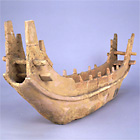Japanese Archaeology and Special Exhibition (Heiseikan) Thematic Exhibition Room
December 4, 2012 (Tue) - March 3, 2013 (Sun)
This thematic exhibition, as part of the annual archaeological objects exchange program of the Agency for Cultural Affairs for this year, consists of artifacts from the Saitobaru Archaeological Museum of Miyazaki Prefecture and items in the Tokyo National Museum collection excavated in Miyazaki and Kagoshima prefectures. These objects introduce the distinctive Kofun culture of southern Kyushu.
It has long been known that in Kyushu, kofun (burial mounds) with characteristics common to those of the Kinai region in central Japan appeared along the coast of northern Setouchi in the early Kofun period (3rd-4th century). In southern Kyushu, an advanced Kofun culture was established as well in the mid-Kofun period (5th century) with groups of kofun such as those at Saitobaru in Miyazaki prefecture. Despite this, the uniqueness of southern Kyushu Kofun culture has been emphasized by factors including its distance from the Kinai region, which is the origin of Kofun culture, and the existence of peculiarly designed tombs.
In recent years, through research by organizations in Miyazaki and Kagoshima prefectures, the establishment of Kofun culture in southern Kyushu has been confirmed as being as early as the early Kofun period. In addition, in the mid-Kofun period, keyhole-shaped mounded tombs now known as the largest in Kyushu were created. Similarly, a comprehensive relationship between large-scale kofun and subterranean burial chambers has been increasingly clarified.
The placement of this distinctive Kofun culture in the Kofun period, in which Japan's ancient state was formed, is a topic for future research, and it is hoped that this exhibition will trigger that research.
The archaeological objects exchange program, now in its 15th year, was founded in 1998 for the reciprocal exchange and exhibition of archaeological objects between Japan's national museums and regional museums, to disseminate information about these objects to the public. This year, this museum also has an exchange with Kitakyushu Museum of Natural History & Human History*.
*The thematic exhibition Bronze Cultures of Northern Kyushu is being held in the Archaeology Gallery in the Heiseikan, October 30, 2012 - March 10, 2013.

